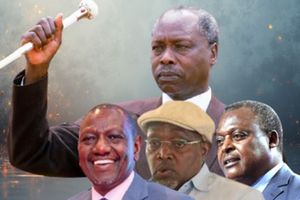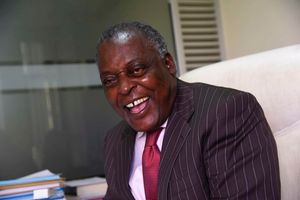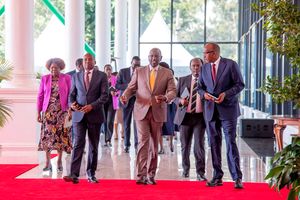Premium
The crass political photograph

In the past year, the cell phone video, the iPhone photo, and a medley of other electronic images have saturated social media and taken over our little brains.
What you need to know:
- The political photograph is a display of humanity posing in ways that the objects think is flattering.
- Usually, the pictures are taken in lush residential backyards.
Since the advent of the camera, the mug has been the coin of fame, or infamy. The photo has been used to catch cheating spouses, put criminals away, or provide instant recognition and notoriety. It’s an illusionist’s magic wand. Don’t believe your lying eyes when you look at a picture. I remember pictures of a couple depicting intoxicating mad love. The next day, they met their maker in a murder-suicide. But photos have also been on the side of angels. I have several of my maternal granddad Mbiti Wa Mbele, a lion of a man who lived to be over 100. However, the use of the political photograph in Kenya threatens to discredit the art of photography.
In the past year – which I shall call the Age of Corona – photographs and photographic images have become the news. The cell phone video, the iPhone photo, and a medley of other electronic images have saturated social media and taken over our little brains. I don’t know how many times in an hour you look at Twitter, FB, Instagram, Tik Tok and other godforsaken temptations of lust and garbage. Or the dark web where resides those among us who are pure evil. I know you can’t help yourself. You must look. Or Tweet. Take my good friend, the omnipresent Ahmednasir Abdullahi, Nairobi’s most visible lawyer. The man tweets every few minutes. He beguiles you with images edited to mislead.
There’s Nairobi’s high-rolling potentate, the unrivalled legal maven Donald Kipkorir. Every Friday – and twice on weekends – Mr Kipkorir hosts lavish parties in his manicured Nairobi estate. In his company are always what we call “beautiful people”. Rich, famous, well-educated, well-dressed, well-travelled, well-read and well-spoken. Mirth wafts in the air as the company of A-listers imbibes the finest wines, rare expensive liquors and fine meats. If you were a sorry sod, you might take your own life in despondency upon seeing the seductive pictures he posts on social media. You would be forgiven to believe he’s a prince and not the once barefoot peasant kid from dusty windswept Cheptongei. It tells you we don’t end up where we started.
Mr Kipkorir has repeatedly said he shares these images to celebrate capitalism in his personal journey from the depths of penury to the summits of power, wealth and pleasure. At best, it’s a rags-to-riches story. At worst, he’s a showboat. But if you judge by the comments on his posts, folks love it. He garners thousands of likes and many entreaties for an invitation, or help from many an impoverished compatriot. It’s unclear whether any of these poor souls have ever been requited. We know this – it’s all great publicity for Mr Kipkorir and his brand. People want to associate with success and so I take it that it hasn’t hurt his legal work. More power to him.
Flaunting their wealth
It’s, however, the explicit political photograph that intrigues me. The political photograph is eye candy, or a meat market of sorts. It’s a display of humanity posing in ways that the objects think is flattering. Except beauty is only in the eye of the beholder. Many of the pictures are of men of high political station. Yet these powerful men find it crucially important to bathe our eyes with their images. Usually, the pictures are taken in lush residential backyards. You’d think you are in some extravagant estate in the American summer. But no – its right here in a Kenya most people never see. These are the men who rule us, and want to desperately continue ruling us.
Which begs the question: why would people who live like kings and are an infinitesimal, very tiny percentage of Kenyans, ostentatiously flaunt their wealth à la Marie Antoinette? Is that how one campaigns before impoverished voters who live on less than two dollars a day? Domestic workers who trek for miles to get to work at their luxurious mansions because they can’t afford bus fare? The stats about this exclusive club are startling. In 2020, out of a population of 55 million, Kenya had a measly 2,900 US-dollar millionaires. Only 42 Kenyans were worth more than $30 million and no Kenyan is a US-dollar billionaire. So, why would this minuscule group want to expose itself to such a hungry populace?
That’s how this select group has been campaigning in the Age of Corona. The pictures are supposed to tell us who’s in which alliance. It’s a show of political might. However, I think they are better advised to take pictures in more austere surroundings with struggling common folk. The truth in the pictures is bitter. We only see the same faces and families – and their protégés – who’ve ruled since independence. That’s hardly inspiring – nyet. You don’t look to a past full of atrocity and hardship if you want a prosperous, equitable and just Kenyan future. One final note – most of the men in those political photographs should hit the gym – hard.
Makau Mutua is SUNY Distinguished Professor and Margaret W. Wong Professor at Buffalo Law School. He’s chair of KHRC. @makaumutua





